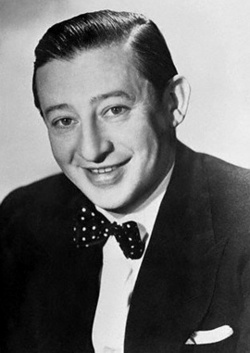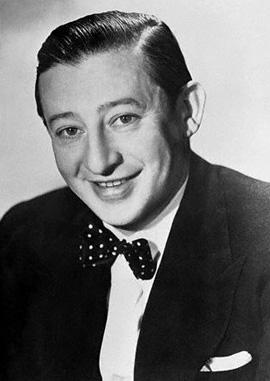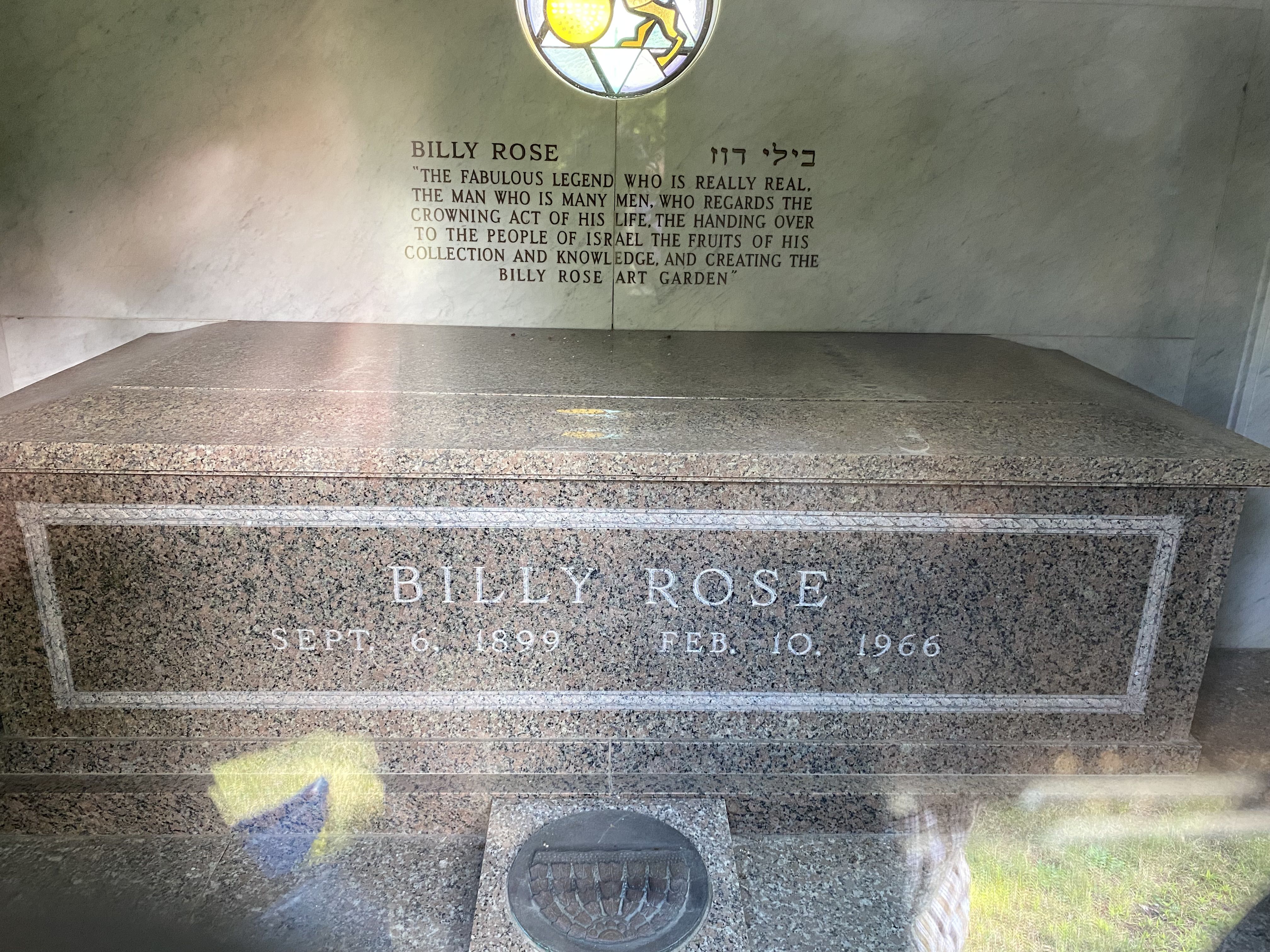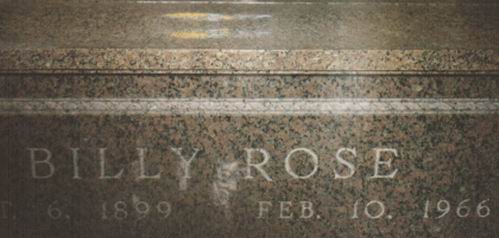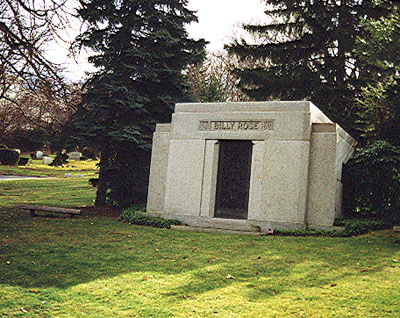Theatrical Producer. Born William Samuel Rosenberg in the Bronx, New York, after graduating from The High School of Commerce, he was trained by John Robert Gregg, the creator of the Gregg shorthand system. At age 16, he won a high-speed dictation contest sponsored by Gregg and was hired by the creator to prove the system's efficiency. During World War I (WWI), he obtained a position as a stenographer in Washington, D.C. to Bernard Baruch who was the head of the War Industries Board. After the war, Rose returned to New York City and began working on Broadway, shortening his name to Billy Rose. His claim as a songwriter and lyricist were at best a title grab with the ultimate goal of receiving royalties. He would suggest clever lyrical changes to the actual songwriter. The writer would name him as a collaborator because of his ability to promote songs while negotiating with music publishers. Songwriters received lucrative royalty checks while subtracting a share for Rose. Songs credited to him were eventual classics "I Found A Million Dollar Baby in a Five and Ten Cent Store," "It's Only a Paper Moon," and "Me and My Shadow." He began producing many successful Broadway productions while both a theatre and nightclub owner. In 1943, he produced the blockbuster "Carmen Jones" with an all-African-American cast (the show was later made into a 1954 film by Otto Preminger and starred Dorothy Dandridge). His production of "Jumbo" starred Jimmy Durante and live elephants on the stage of the Hippodrome Theatre (it was also made into a film in 1962 starring Doris Day). His nightclub, known as Billy Rose's Diamond Horseshoe, became famous for its vaudeville-style shows including a chorus line of 250-pound women. The night club inspired musical films of the same name starring Betty Grable in 1940 and another in 1945 featuring Gene Kelly. Rose's extravaganza productions away from Broadway became famous. His first in 1934 was for "Fort Worth Frontier Days" with the construction of a huge elaborate dinner theatre called "Casa Manana" which featured entertainer Sally Rand appearing on the world's largest revolving stage. Rose introduced "The Aquacade" to Cleveland's Great Lakes Exposition in 1936. It was a floating amphitheater featuring a water ballet with hundreds of swimmers including Johnny Weissmuller. At the 1939 World's Fair in New York, his show "Billy Rose's Aquacade" was once again resurrected and starred Olympic medal winner swimmer Eleanor Holm. The all-girl show attracted the Fair's largest crowds until it closed. Rose took the Aquacade to San Francisco, California, for the World's Fair in 1940. In 1947, Rose began writing "Pitching Horseshoes," a weekly column which at its peak ran in over 200 newspapers across the United States. He was an immensely wealthy man when he died of lobar pneumonia at his vacation home in Montego Bay, Jamaica, at the age of 66. Rose was one of three founders of the Songwriters Protective Association (SPA) now The Songwriters Guild of America (SGA). His photo graced the cover of the June 2, 1947, edition of "Time Magazine." Inside was a feature story about his new nightclub, the refurbished Glen Island Casino. The Theatre Collection, a repository for the documents of theatre past and present at the New York City Public Library, was renamed the Billy Rose Theatre Collection by virtue of a major financial gift from his estate which enabled the facility to organize its vast holdings while making more purchases of theatre-related materials. Books about him are "Billy Rose: Manhattan Primitive" by Earl Conrad and "The Nine Lives of Billy Rose: An Intimate Biography" by Polly Rose Gottlieb.
Theatrical Producer. Born William Samuel Rosenberg in the Bronx, New York, after graduating from The High School of Commerce, he was trained by John Robert Gregg, the creator of the Gregg shorthand system. At age 16, he won a high-speed dictation contest sponsored by Gregg and was hired by the creator to prove the system's efficiency. During World War I (WWI), he obtained a position as a stenographer in Washington, D.C. to Bernard Baruch who was the head of the War Industries Board. After the war, Rose returned to New York City and began working on Broadway, shortening his name to Billy Rose. His claim as a songwriter and lyricist were at best a title grab with the ultimate goal of receiving royalties. He would suggest clever lyrical changes to the actual songwriter. The writer would name him as a collaborator because of his ability to promote songs while negotiating with music publishers. Songwriters received lucrative royalty checks while subtracting a share for Rose. Songs credited to him were eventual classics "I Found A Million Dollar Baby in a Five and Ten Cent Store," "It's Only a Paper Moon," and "Me and My Shadow." He began producing many successful Broadway productions while both a theatre and nightclub owner. In 1943, he produced the blockbuster "Carmen Jones" with an all-African-American cast (the show was later made into a 1954 film by Otto Preminger and starred Dorothy Dandridge). His production of "Jumbo" starred Jimmy Durante and live elephants on the stage of the Hippodrome Theatre (it was also made into a film in 1962 starring Doris Day). His nightclub, known as Billy Rose's Diamond Horseshoe, became famous for its vaudeville-style shows including a chorus line of 250-pound women. The night club inspired musical films of the same name starring Betty Grable in 1940 and another in 1945 featuring Gene Kelly. Rose's extravaganza productions away from Broadway became famous. His first in 1934 was for "Fort Worth Frontier Days" with the construction of a huge elaborate dinner theatre called "Casa Manana" which featured entertainer Sally Rand appearing on the world's largest revolving stage. Rose introduced "The Aquacade" to Cleveland's Great Lakes Exposition in 1936. It was a floating amphitheater featuring a water ballet with hundreds of swimmers including Johnny Weissmuller. At the 1939 World's Fair in New York, his show "Billy Rose's Aquacade" was once again resurrected and starred Olympic medal winner swimmer Eleanor Holm. The all-girl show attracted the Fair's largest crowds until it closed. Rose took the Aquacade to San Francisco, California, for the World's Fair in 1940. In 1947, Rose began writing "Pitching Horseshoes," a weekly column which at its peak ran in over 200 newspapers across the United States. He was an immensely wealthy man when he died of lobar pneumonia at his vacation home in Montego Bay, Jamaica, at the age of 66. Rose was one of three founders of the Songwriters Protective Association (SPA) now The Songwriters Guild of America (SGA). His photo graced the cover of the June 2, 1947, edition of "Time Magazine." Inside was a feature story about his new nightclub, the refurbished Glen Island Casino. The Theatre Collection, a repository for the documents of theatre past and present at the New York City Public Library, was renamed the Billy Rose Theatre Collection by virtue of a major financial gift from his estate which enabled the facility to organize its vast holdings while making more purchases of theatre-related materials. Books about him are "Billy Rose: Manhattan Primitive" by Earl Conrad and "The Nine Lives of Billy Rose: An Intimate Biography" by Polly Rose Gottlieb.
Bio by: Donald Greyfield
Family Members
Advertisement
